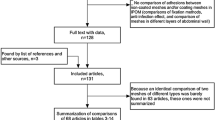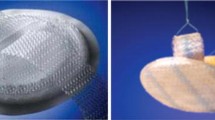Summary
The repair of inguinal or incisional hernias may occasionally require the placement of an intraabdominal mesh to reinforce parietal wall defects or weaknesses. An original composite mesh, consisting of a conventional polyester mesh combined with a coated hydrophilic and absorbable membrane designed to prevent intraperitoneal adhesions was evaluated. The efficacy of the product was tested through three experiments. The first carefully examined the absorption properties of the hydrophilic film as well as the biocompatibility of the patch after subcutaneous implantation. The second experiment was designed to evaluate adhesion formation in an animal model, comparing the mesh to two other commercially available membranes and to a control. In the third experiment, the product was tested in a porcine model. This was done in order to better evaluate the performance of the mesh in a model closer to human dimensions. These three experimental procedures demonstrated the biocompatibility of the membrane, the dramatically superior performance of the patch compared to other commercially available ones and to controls, and the validity of the concept in large animals. The composite mesh made of polyester and coated hydrogel fulfils the conditions for human evaluation.
Similar content being viewed by others
References
Amid K, Shulman G, Lichtenstein L, Sostrin S, Young J, Hakakha M (1995) Preliminary evaluation of composite materials for the repair of incisional hernias. Ann Chir 49: 539–543
Baykal A, Onat D, Rasa K, Renda N, Sayek I (1997) Effects of polyglycolic acid and polypropylene meshes on postoperative adhesion formation in mice. World J Surg 21: 579–583
Becker JM, Dayton MT, Fazio VW, Beck DE, Stryker SJ, Wexner SD, Wolff BG, Roberts PL, Smith LE, Sweeney SA, Moore M (1996) Prevention of postoperative abdominal adhesions by a sodium hyaluronate-based bioresorbable membrane: a prospective, randomized, double-blind multicenter study. J Am Coll Surg 183: 297–306
Benchetrit S, Debaert M, Detruit B, Dufilho A, Gaujoux D, Lagoutte J, Lepère M, Martin Saint Leon L, Paris d'Escurac X, Rico E, Sorrentino J, Thérin M (1998) Laparoscopic and open abdominal wall reconstruction using PARIETEX® meshes: clinical results on 2700 hernias. Hernia 2: 57–62
diZerega GS (1994) Contemporary adhesion prevention. Fertil Steril 61: 219–235
Ellis H (1982) The causes and prevention of intestinal adhesions. Br J Surg 69: 241–243
Gury JF, Mutter D, Gravagna P, Kanor M, Aprahamian M, Marescaux J (1998) Prévention des adhérences post-opératoires par un biomatériau collagénique adhésif. Ann Chir 52: 672–673
Harris ES, Morgan RF, Rodeheaver GT (1995) Analysis of the kinetics of peritoneal adhesion formation in the rat and evaluation of potential antiadhesive agents. Surg 117: 663–669
Luijendijk RW, deLange DCD, Wauters CCAP, Hop WCG, Duron JJ, Pailler JL, Camprodon PR, Holmdahl L, vanGeldorp HJ, Jeekel J (1996) Foreign material in postoperative adhesions. Ann Surg 223: 242–248
Milligan DW, Raftery AT (1974) Observations on the pathogenesis of peritoneal adhesions: a light and electron microscopical study. Br J Surg 61: 274–280
Nagler A, Rivkind AI, Raphael J, Levi-Schaffer F, Genina O, Lavelin I, Pines M (1998) Halofuginone: an inhibitor of collagen type I synthesis prevents postoperative formation of abdominal adhesions. Ann Surg 227: 575–582
Spaw AT, Ennis BW, Spaw LP (1991) Laparoscopic hernia repair: the anatomic basis. J Laparoendosc Surg 1: 269–277
Thérin M, Mutter D, Diemunsch P, Rodeheaver GT (1998) Preclinical evaluation of a new composite mesh (collagen-polyester) for intraperitoneal hernia repair with the selective property of tissue incorporation on one side without adhesion formation on the opposite side (abstract 22). Hernia 2 [Suppl.2]: S27
Tsimoyiannis EC, Tassis A, Glantzounis G, Jabarin M, Siakas P, Tzourou H (1998) Laparoscopic intraperitoneal onlay mesh repair of incisional hernia. Surg Lap Endosc 8: 360–362
Wool NL, Strauss AK, Roseman DL (1985) Clinical experience with the GoreTex soft tissue patch in hernia repair: a preliminary report. Proc Inst Med Chicago 38: 33–37
Author information
Authors and Affiliations
Rights and permissions
About this article
Cite this article
Mutter, D., Jamali, F.R., Moody, D.L. et al. The concept of protected mesh to minimize adhesion formation in intraperitoneat abdominal wall reinforcement. Preclinical evaluation of a new composite mesh. Hernia 4 (Suppl 1), S3–S9 (2000). https://doi.org/10.1007/BF01387175
Issue Date:
DOI: https://doi.org/10.1007/BF01387175




